Prioritized Decision Support System for Cybersecurity Selection Based on Extended Symmetrical Linear Diophantine Fuzzy Hamacher Aggregation Operators
Abstract
1. Introduction
1.1. Literature Review
1.2. Contribution and Novelty
- LDFS is a flexible method that overcomes MD and NMD limitations in existing models like IFSs, PFSs, and q-ROFSs. It allows decision makers to select grades within the [0, 1] range and utilize reference or control characteristics as weight vectors, facilitating the classification of physical attributes and the handling of ambiguous data.
- Hamacher AOs are utilized to facilitate seamless information integration while prioritized operators connect various criteria according to their importance. To maximize the potential of these operators, we are developing new hybrid AOs.
- We suggest two hybrid AOs to mitigate the effects of extremely large or small values in DM on overall rankings. These are the LDFHPWA and LDFHPWG operators.
- Several appealing aspects of the suggested AOs are also examined, including boundary conditions, idempotence, and monotonicity.
- A new DM approach utilizing the proposed operators is introduced to address MCDM problems.
- A novel DM method incorporating the proposed operators is introduced to tackle MCDM challenges.
1.3. Motivation for This Research
2. Preliminaries
2.1. Linear Diophantine Fuzzy Set (LDFS)
2.2. Expectation Score Function
2.3. Hamacher Operations
2.4. The Operational Laws for LDFNs Based on Hamacher Operations
- ;
- ;
- ;
- .
3. Linear Diophantine Fuzzy Hamacher Prioritized Aggregation Operators
3.1. LDF Hamacher Prioritized Weighted Average (LDFHPWA) Operator
3.2. LDF Hamacher Prioritized Weighted Geometric (LDFHPWG) Operator
4. MCGDM Method with LDF Information
| Algorithm 1 |
| Step 1: Construct the LDF decision matrices , where |
| , and can be illustrated as follows. |
| Step 2: Determine the value of as follows: |
| such that |
| Step 3: Aggregate the LDF decision matrix into the combined LDF decision matrix by applying the LDFHPWA or LDFHPWG operator. |
| Step 4: Determine the value of such that . |
| Step 5: For each decision, aggregate all . Use the LDFHPWA or LDFHPWG operator on . |
| Step 6: Rank every alternative based on using the score function. |
| Step 7: Select the alternative that has the greatest score. |
5. Numerical Example
- : Security Effectiveness (SE)
- : Cost-Effectiveness (CE)
- : Network Segmentation (NS)
- : Threat Intelligence (TI)
- : Patch Management (PM)
5.1. Explanation of Criteria
- ♦
- SE: The cybersecurity solution’s capability to accurately detect and prevent threats.
- ♦
- CE: The entire cost-benefit analysis of implementing a cybersecurity solution taking into account both the initial and continuing maintenance costs as well as the value it provides in terms of risk reduction.
- ♦
- NS: Partitioning the smart grid into distinct zones or segments helps to reduce the impact of security breaches and restricts attackers’ movement across various network areas.
- ♦
- TI: Leveraging advanced methods and tools, along with timely and accurate threat intelligence such as real-time threat detection, analysis, and sharing of compromise indicators, can significantly bolster proactive cybersecurity measures.
- ♦
- PM: The ability to effectively manage and implement software patches and updates to address security vulnerabilities and keep the system current with the latest protection measures.
5.2. Comparison Analysis with Existing Methods
5.3. Sensitivity Analysis
5.4. Advantages of the Proposed Method
- a.
- The most significant aspect of LDFSs is their capacity to express RP occurrences that require the allocation of MD and NMD. This feature makes LDFSs more dominating in expressing the needed information, overcoming the shortcomings of previous theories such as LDFSs and q-ROFSs.
- b.
- The LDFS model addresses imprecision and periodicity at the same time, expanding on prior models.
- c.
- Prioritized AOs capture prioritization phenomena among aggregated arguments, enhancing decision making in real-life scenarios. They were applied to LDFSs while maintaining their advantages.
- d.
- The suggested AOs are useful to aggregate fuzzy priorities and weights for evaluating alternatives in decision-making problems, such as project selection or resource allocation.
- e.
- The proposed method can be used to aggregate fuzzy opinions and priorities from multiple experts or stakeholders in group decision-making scenarios.
- f.
- The proposed method can be utilized to evaluate fuzzy quality metrics and prioritize weights for defect detection or quality improvement.
- g.
- The proposed approach is more versatile and convenient for handling common MCGDM issues.
- h.
- These applications leverage the ability of the implemented AOs to handle fuzzy information, prioritize weights, and aggregate data in a flexible and robust manner.
6. Conclusions
Author Contributions
Funding
Data Availability Statement
Conflicts of Interest
References
- Bouramdane, A.A. Cyberattacks in smart grids: Challenges and solving the multi-criteria decision-making for cybersecurity options, including ones that incorporate artificial intelligence, using an analytical hierarchy process. J. Cybersecur. Priv. 2023, 3, 662–705. [Google Scholar] [CrossRef]
- Woo, P.S.; Kim, B.H. Methodology of cyber security assessment in the smart grid. J. Electr. Eng. Technol. 2017, 12, 495–501. [Google Scholar] [CrossRef]
- Ansari, M.; Asrari, A. Reaction to detected cyberattacks in smart distribution systems. In Proceedings of the 2020 IEEE Power & Energy Society Innovative Smart Grid Technologies Conference (ISGT), Washington, DC, USA, 17–20 February 2020; pp. 1–5. [Google Scholar]
- Alkuwari, A.N.; Al-Kuwari, S.; Qaraqe, M. Anomaly detection in smart grids: A survey from cybersecurity perspective. In Proceedings of the 2022 3rd International Conference on Smart Grid and Renewable Energy (SGRE), Doha, Qatar, 20–22 March 2022; pp. 1–7. [Google Scholar]
- Liu, Q.; Hagenmeyer, V.; Keller, H.B. A review of rule learning-based intrusion detection systems and their prospects in smart grids. IEEE Access 2021, 9, 57542–57564. [Google Scholar] [CrossRef]
- Alwageed, H.S. Detection of cyber attacks in smart grids using SVM-boosted machine learning models. Serv. Oriented Comput. Appl. 2022, 16, 313–326. [Google Scholar] [CrossRef]
- Zhai, F.; Yang, T.; Zhao, B.; Chen, H. Privacy-preserving outsourcing algorithms for multidimensional data encryption in smart grids. Sensors 2022, 22, 4365. [Google Scholar] [CrossRef] [PubMed]
- Miller, M.Z.; Griendling, K.; Mavris, D.N. Exploring human factors effects in the smart grid system of systems demand response. In Proceedings of the 2012 7th International Conference on System of Systems Engineering (SoSE), Genova, Italy, 16–19 July 2012; pp. 1–6. [Google Scholar]
- Fredman, D. A Human Side of the Smart Grid: Behavior-Based Energy Efficiency from Renters Using Real-Time Feedback and Competitive Performance-Based Incentives; The University of Vermont and State Agricultural College: Burlington, VT, USA, 2018. [Google Scholar]
- Montañez, R.; Golob, E.; Xu, S. Human cognition through the lens of social engineering cyberattacks. Front. Psychol. 2020, 11, 1755. [Google Scholar] [CrossRef]
- Ray, J.R. Training Programs to Increase Cybersecurity Awareness and Compliance in Non-Profits. 2014. Available online: https://scholarsbank.uoregon.edu/items/8a6c47a2-8e7d-4bc6-92df-719fb3ede12f (accessed on 2 December 2022).
- Loi, M.; Christen, M. Ethical frameworks for cybersecurity. In The Ethics of Cybersecurity; Springer: Berlin/Heidelberg, Germany, 2020; pp. 73–95. [Google Scholar]
- Rahman, M.A.; Manshaei, M.H.; Al-Shaer, E.; Shehab, M. Secure and private data aggregation for energy consumption scheduling in smart grids. IEEE Trans. Dependable Secur. Comput. 2015, 14, 221–234. [Google Scholar] [CrossRef]
- Albasrawi, M.N.; Jarus, N.; Joshi, K.A.; Sarvestani, S.S. Analysis of reliability and resilience for smart grids. In Proceedings of the 2014 IEEE 38th Annual Computer Software and Applications Conference, Vasteras, Sweden, 21–25 July 2014; pp. 529–534. [Google Scholar]
- Kanca, A.M.; Sağiroğlu, Ş. Sharing cyber threat intelligence and collaboration. In Proceedings of the 2021 International Conference on Information Security and Cryptology (ISCTURKEY), Ankara, Turkey, 2–3 December 2021; pp. 167–172. [Google Scholar]
- Majumder, M.; Majumder, M. Multi criteria decision making. In Impact of Urbanization on Water Shortage in Face of Climatic Aberrations; Springer: Berlin/Heidelberg, Germany, 2015; pp. 35–47. [Google Scholar]
- Triantaphyllou, E.; Triantaphyllou, E. Multi-Criteria Decision Making Methods; Springer: Berlin/Heidelberg, Germany, 2000; pp. 5–21. [Google Scholar]
- Zadeh, L.A. Fuzzy sets. Inf. Control 1965, 8, 338–353. [Google Scholar] [CrossRef]
- Atanassov, K.T. On Intuitionistic Fuzzy Sets Theory; Springer: Berlin/Heidelberg, Germany, 2012; Volume 283. [Google Scholar]
- Yager, R.R. Pythagorean fuzzy subsets. In Proceedings of the 2013 Joint IFSA World Congress and NAFIPS Annual Meeting (IFSA/NAFIPS), Edmonton, AB, Canada, 24–28 June 2013; pp. 57–61. [Google Scholar]
- Yager, R.R. Generalized orthopair fuzzy sets. IEEE Trans. Fuzzy Syst. 2016, 25, 1222–1230. [Google Scholar] [CrossRef]
- Khan, M.J.; Kumam, P.; Shutaywi, M.; Kumam, W. Improved Knowledge Measures for q-Rung Orthopair Fuzzy Sets. Int. J. Comput. Intell. Syst. 2021, 14, 1700–1713. [Google Scholar] [CrossRef]
- Khan, M.J.; Kumam, P.; Shutaywi, M. Knowledge measure for the q-rung orthopair fuzzy sets. Int. J. Intell. Syst. 2021, 36, 628–655. [Google Scholar] [CrossRef]
- Khan, M.J.; Ali, M.I.; Kumam, P.; Kumam, W.; Al-Kenani, A.N. q-Rung orthopair fuzzy modified dissimilarity measure based robust VIKOR method and its applications in mass vaccination campaigns in the context of COVID-19. IEEE Access 2021, 9, 93497–93515. [Google Scholar] [CrossRef]
- Riaz, M.; Hashmi, M.R. Linear Diophantine fuzzy set and its applications towards multi-attribute decision-making problems. J. Intell. Fuzzy Syst. 2019, 37, 5417–5439. [Google Scholar] [CrossRef]
- Iampan, A.; García, G.S.; Riaz, M.; Athar Farid, H.M.; Chinram, R. Linear Diophantine fuzzy Einstein aggregation operators for multi-criteria decision-making problems. J. Math. 2021, 1, 5548033. [Google Scholar] [CrossRef]
- Ayub, S.; Shabir, M.; Riaz, M.; Mahmood, W.; Bozanic, D.; Marinkovic, D. Linear diophantine fuzzy rough sets: A new rough set approach with decision making. Symmetry 2022, 14, 525. [Google Scholar] [CrossRef]
- Jeevitha, K.; Garg, H.; Vimala, J.; Aljuaid, H.; Abdel-Aty, A.H. Linear diophantine multi-fuzzy aggregation operators and its application in digital transformation. J. Intell. Fuzzy Syst. 2023, 45, 3097–3107. [Google Scholar] [CrossRef]
- Mohammad, M.M.S.; Abdullah, S.; Al-Shomrani, M.M. Some linear Diophantine fuzzy similarity measures and their application in decision making problem. IEEE Access 2022, 10, 29859–29877. [Google Scholar] [CrossRef]
- Xu, Z.; Yager, R.R. Some geometric aggregation operators based on intuitionistic fuzzy sets. Int. J. Gen. Syst. 2006, 35, 417–433. [Google Scholar] [CrossRef]
- Hamacher, H.; Trappl, R.; Klir, G.H.; Riccardi, L. In Progress in Cybernatics and Systems Research. Uber Logische Verknunpfungenn Unssharfer Aussagen Und Deren Zugenhorige Bewertungsfunktione 1978, 3, 276–288. [Google Scholar]
- Liu, P. Some Hamacher aggregation operators based on the interval-valued intuitionistic fuzzy numbers and their application to group decision making. IEEE Trans. Fuzzy Syst. 2013, 22, 83–97. [Google Scholar] [CrossRef]
- Tan, C.; Yi, W.; Chen, X. Hesitant fuzzy Hamacher aggregation operators for multicriteria decision making. Appl. Soft Comput. 2015, 26, 325–349. [Google Scholar] [CrossRef]
- Huang, J.Y. Intuitionistic fuzzy Hamacher aggregation operators and their application to multiple attribute decision making. J. Intell. Fuzzy Syst. 2014, 27, 505–513. [Google Scholar] [CrossRef]
- Wu, S.J.; Wei, G.W. Pythagorean fuzzy Hamacher aggregation operators and their application to multiple attribute decision making. Int. J. Knowl. Based Intell. Eng. Syst. 2017, 21, 189–201. [Google Scholar] [CrossRef]
- Darko, A.P.; Liang, D. Some q-rung orthopair fuzzy Hamacher aggregation operators and their application to multiple attribute group decision making with modified EDAS method. Eng. Appl. Artif. Intell. 2020, 87, 103259. [Google Scholar] [CrossRef]
- Shams, M.; Abdullah, S.; Khan, F.; Ali, R.; Muhammad, S. Fuzzy Decision Support Systems for Selection of NEA Detection Technologies Under Non-Linear Diophantine Fuzzy Hamacher Aggregation Information. IEEE Access 2024, 12, 32111–32139. [Google Scholar] [CrossRef]
- Zhang, S.; Li, X.; Meng, F. An approach to intuitionistic fuzzy multi-attribute group decision making based on hybrid Einstein aggregation operators. Int. J. Intell. Inf. Database Syst. 2016, 9, 315–343. [Google Scholar] [CrossRef]
- Hadi, A.; Khan, W.; Khan, A. A novel approach to MADM problems using Fermatean fuzzy Hamacher aggregation operators. Int. J. Intell. Syst. 2021, 36, 3464–3499. [Google Scholar] [CrossRef]
- Seikh, M.R.; Mandal, U. Intuitionistic fuzzy Dombi aggregation operators and their application to multiple attribute decision-making. Granul. Comput. 2021, 6, 473–488. [Google Scholar] [CrossRef]
- Akram, M.; Dudek, W.A.; Dar, J.M. Pythagorean Dombi fuzzy aggregation operators with application in multicriteria decision-making. Int. J. Intell. Syst. 2019, 34, 3000–3019. [Google Scholar] [CrossRef]
- Aydemir, S.B.; Yilmaz Gunduz, S. Fermatean fuzzy TOPSIS method with Dombi aggregation operators and its application in multi-criteria decision making. J. Intell. Fuzzy Syst. 2020, 39, 851–869. [Google Scholar] [CrossRef]
- Yager, R.R. Prioritized aggregation operators. Int. J. Approx. Reason. 2008, 48, 263–274. [Google Scholar] [CrossRef]
- Yu, D. Intuitionistic fuzzy prioritized operators and their application in multi-criteria group decision making. Technol. Econ. Dev. Econ. 2013, 19, 1–21. [Google Scholar] [CrossRef]
- Verma, R.; Sharma, B. Intuitionistic fuzzy Einstein prioritized weighted average operators and their application to multiple attribute group decision making. Appl. Math. Inf. Sci. 2015, 9, 3095. [Google Scholar]
- Arora, R.; Garg, H. Prioritized averaging/geometric aggregation operators under the intuitionistic fuzzy soft set environment. Sci. Iran 2018, 25, 466–482. [Google Scholar] [CrossRef]
- Khan, M.S.A.; Abdullah, S.; Ali, A.; Amin, F. Pythagorean fuzzy prioritized aggregation operators and their application to multi-attribute group decision making. Granul. Comput. 2019, 4, 249–263. [Google Scholar] [CrossRef]
- Gao, H. Pythagorean fuzzy Hamacher prioritized aggregation operators in multiple attribute decision making. J. Intell. Fuzzy Syst. 2018, 35, 2229–2245. [Google Scholar] [CrossRef]
- Jan, A.; Khan, A.; Khan, W.; Afridi, M. A novel approach to MADM problems using Fermatean fuzzy Hamacher prioritized aggregation operators. Soft Comput. 2021, 25, 13897–13910. [Google Scholar] [CrossRef]
- Akram, M.; Khan, A.; Alcantud, J.C.R.; Santos-García, G. A hybrid decision-making framework under complex spherical fuzzy prioritized weighted aggregation operators. Expert Syst. 2021, 38, e12712. [Google Scholar] [CrossRef]
- Riaz, M.; Farid, H.M.A.; Aslam, M.; Pamucar, D.; Bozanić, D. Novel approach for third-party reverse logistic provider selection process under linear Diophantine fuzzy prioritized aggregation operators. Symmetry 2021, 13, 1152. [Google Scholar] [CrossRef]
- Farid, H.M.A.; Riaz, M.; Khan, M.J.; Kumam, P.; Sitthithakerngkiet, K. Sustainable thermal power equipment supplier selection by Einstein prioritized linear Diophantine fuzzy aggregation operators. Aims Math. 2022, 7, 11201–11242. [Google Scholar] [CrossRef]
- Gül, S.; Aydoğdu, A. Novel distance and entropy definitions for linear Diophantine fuzzy sets and an extension of TOPSIS (LDF-TOPSIS). Expert Syst. 2023, 40, e13104. [Google Scholar] [CrossRef]
- Khan, M.S.A.; Jana, C.; Khan, M.T.; Mahmood, W.; Pal, M.; Mashwani, W.K. Extension of GRA method for multiattribute group decision making problem under linguistic Pythagorean fuzzy setting with incomplete weight information. Int. J. Intell. Syst. 2022, 37, 9726–9749. [Google Scholar] [CrossRef]
- Qiyas, M.; Khan, N.; Naeem, M.; Okyere, S. Decision-Making Based on Spherical Linear Diophantine Fuzzy Rough Aggregation Operators and EDAS Method. J. Math. 2023, 2023, 5839410. [Google Scholar] [CrossRef]
- Karuppiah, K.; Sankaranarayanan, B.; Ali, S.M.; Marimuthu, U. Integrated approach for offshore wind turbine site selection: Implications for sustainability in power supply chain. Energies 2024, 17, 3419. [Google Scholar] [CrossRef]
- Hussain, A.; Ullah, K.; Pamucar, D.; Simic, V. Intuitionistic fuzzy Sugeno-Weber decision framework for sustainable digital security assessment. Eng. Appl. Artif. Intell. 2024, 137, 109085. [Google Scholar] [CrossRef]
Disclaimer/Publisher’s Note: The statements, opinions and data contained in all publications are solely those of the individual au-thor(s) and contributor(s) and not of MDPI and/or the editor(s). MDPI and/or the editor(s) disclaim responsibility for any injury to people or property resulting from any ideas, methods, instructions or products referred to in the content. |

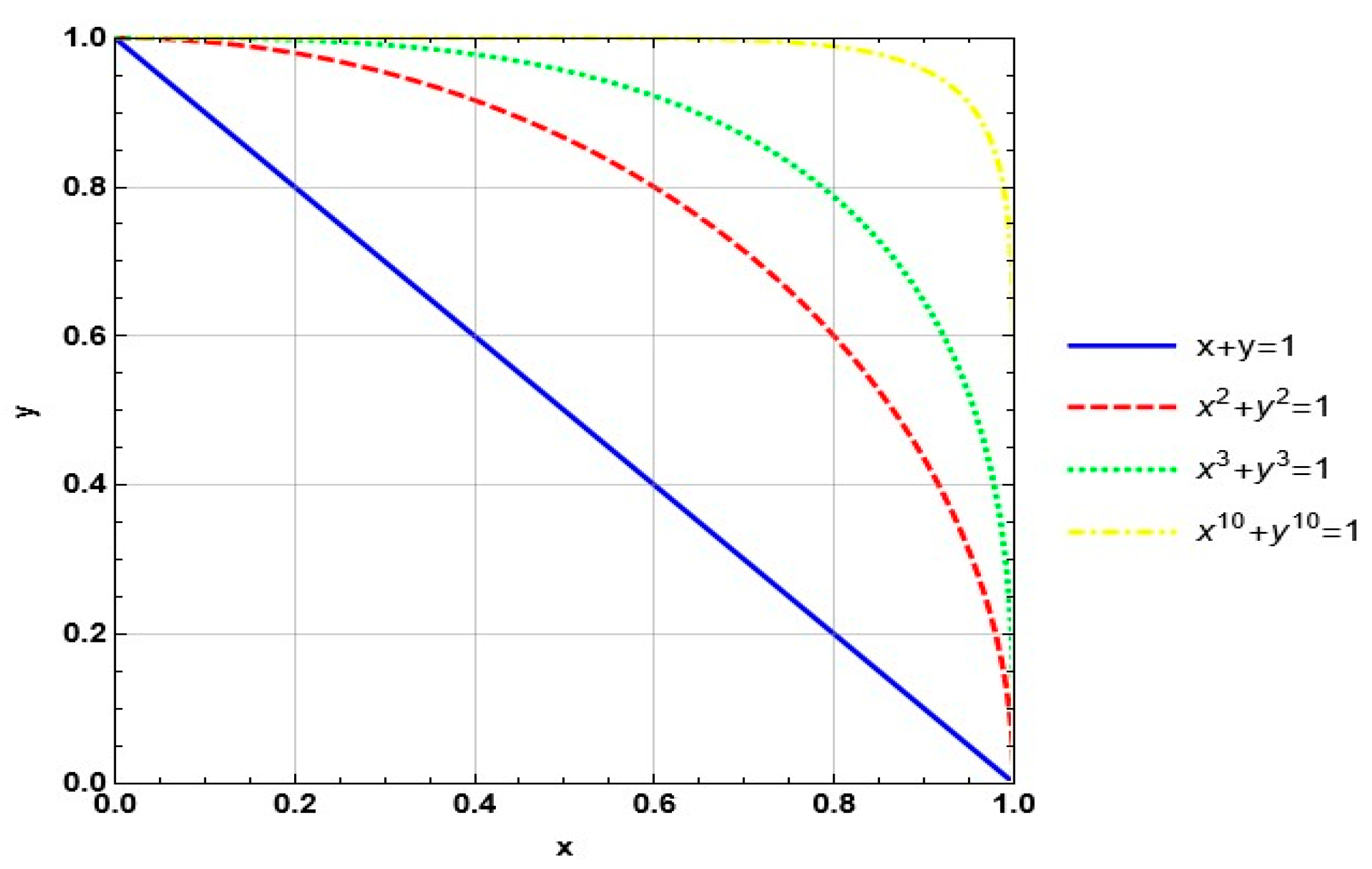
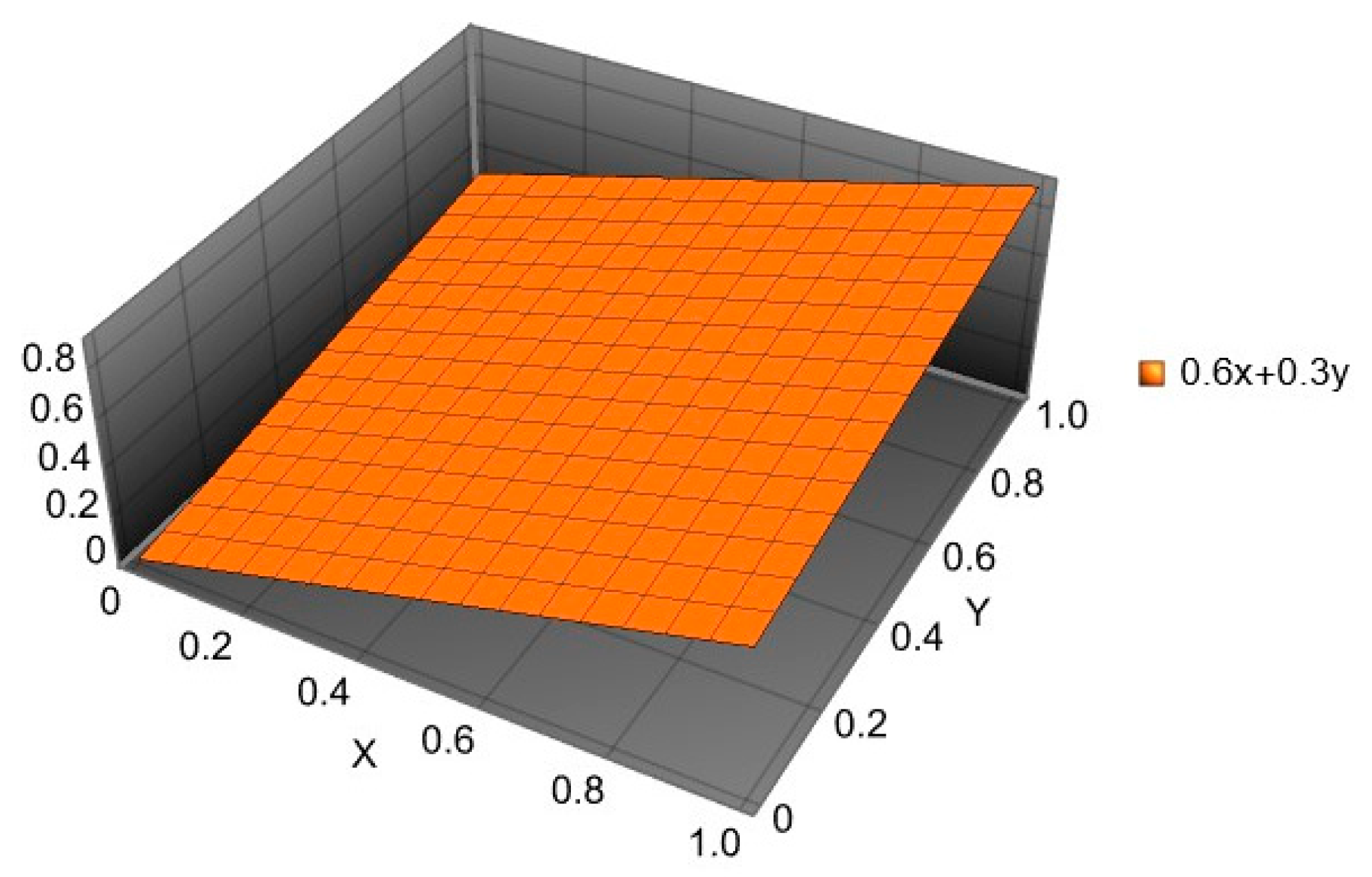
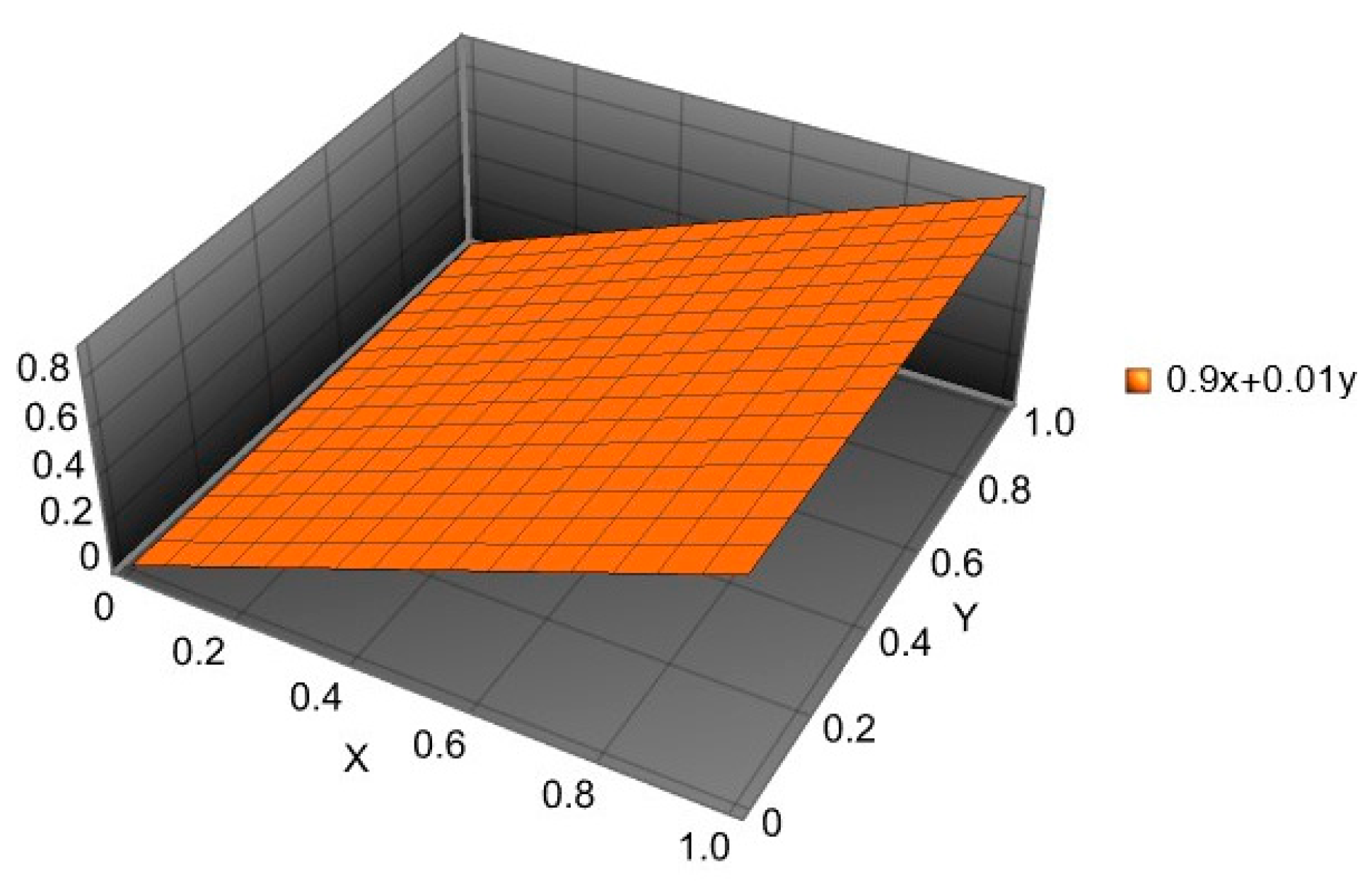
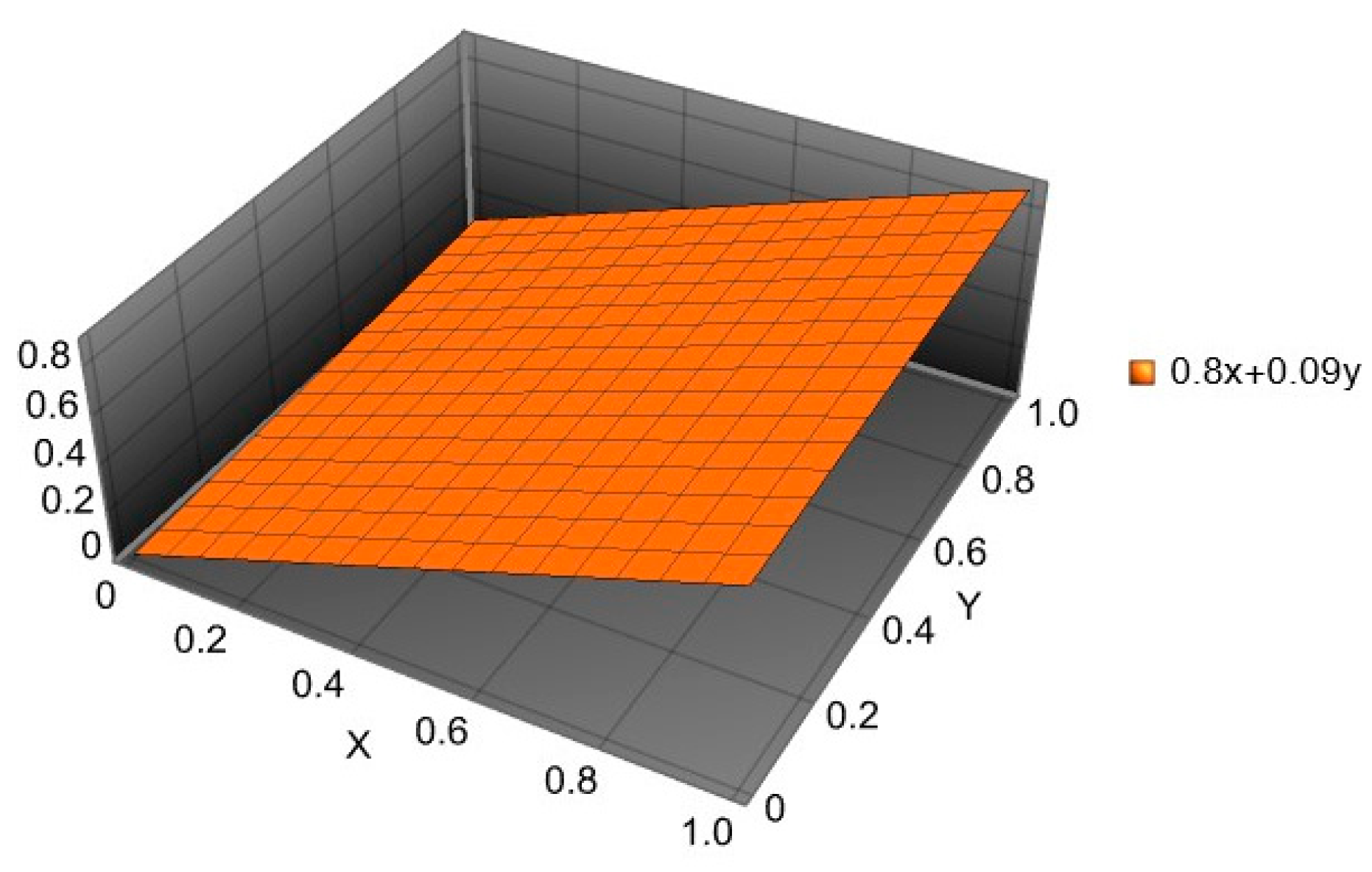
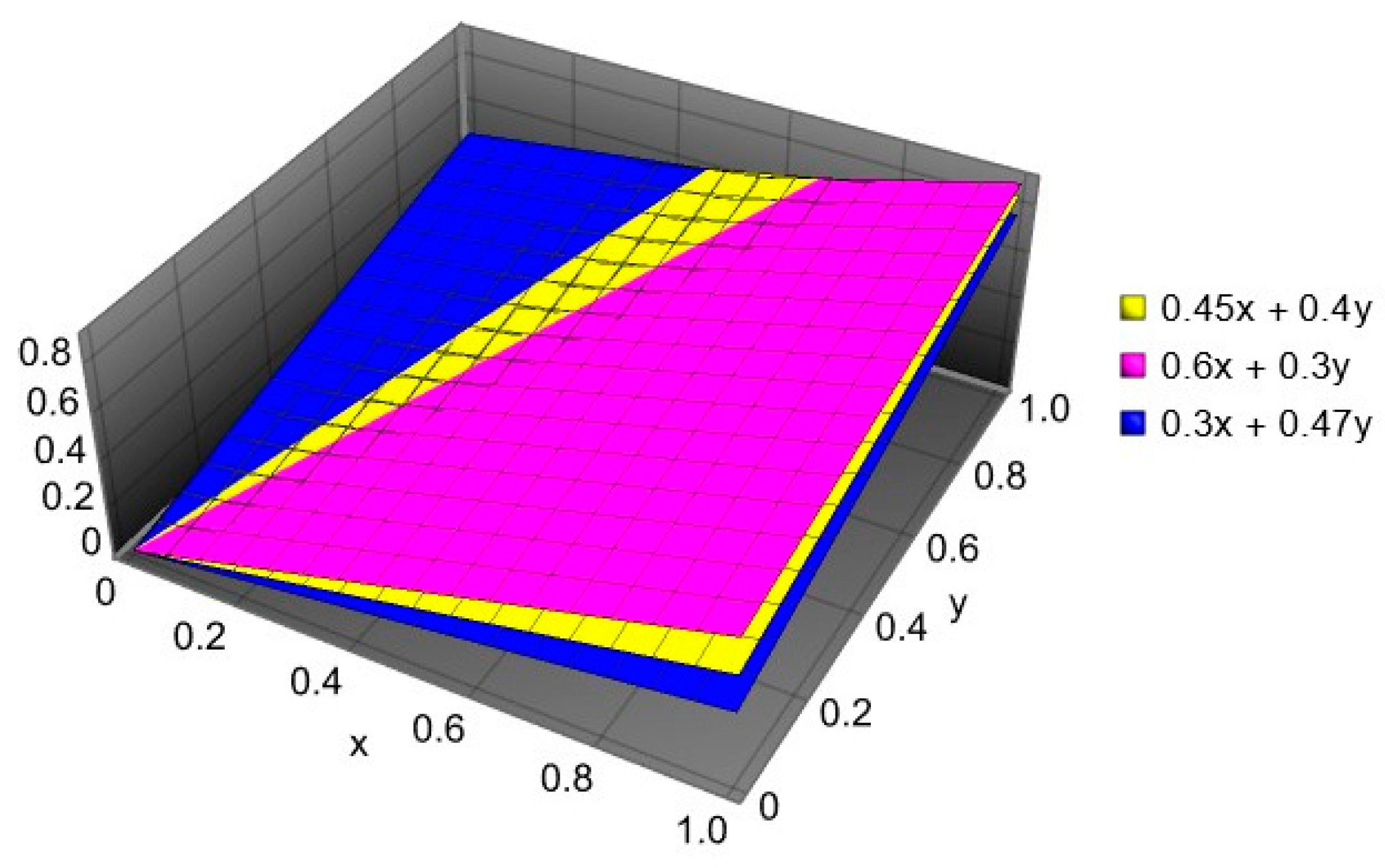
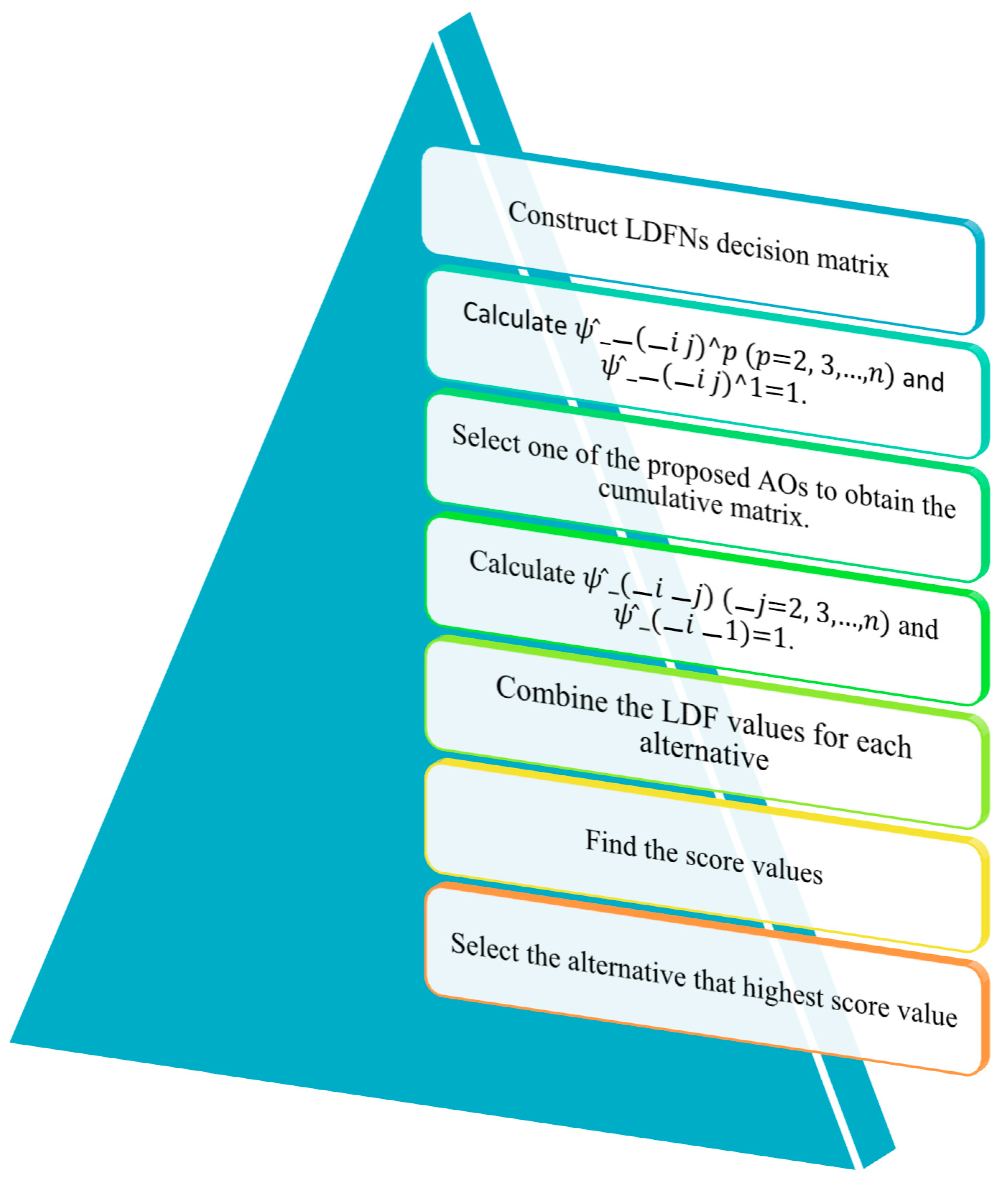
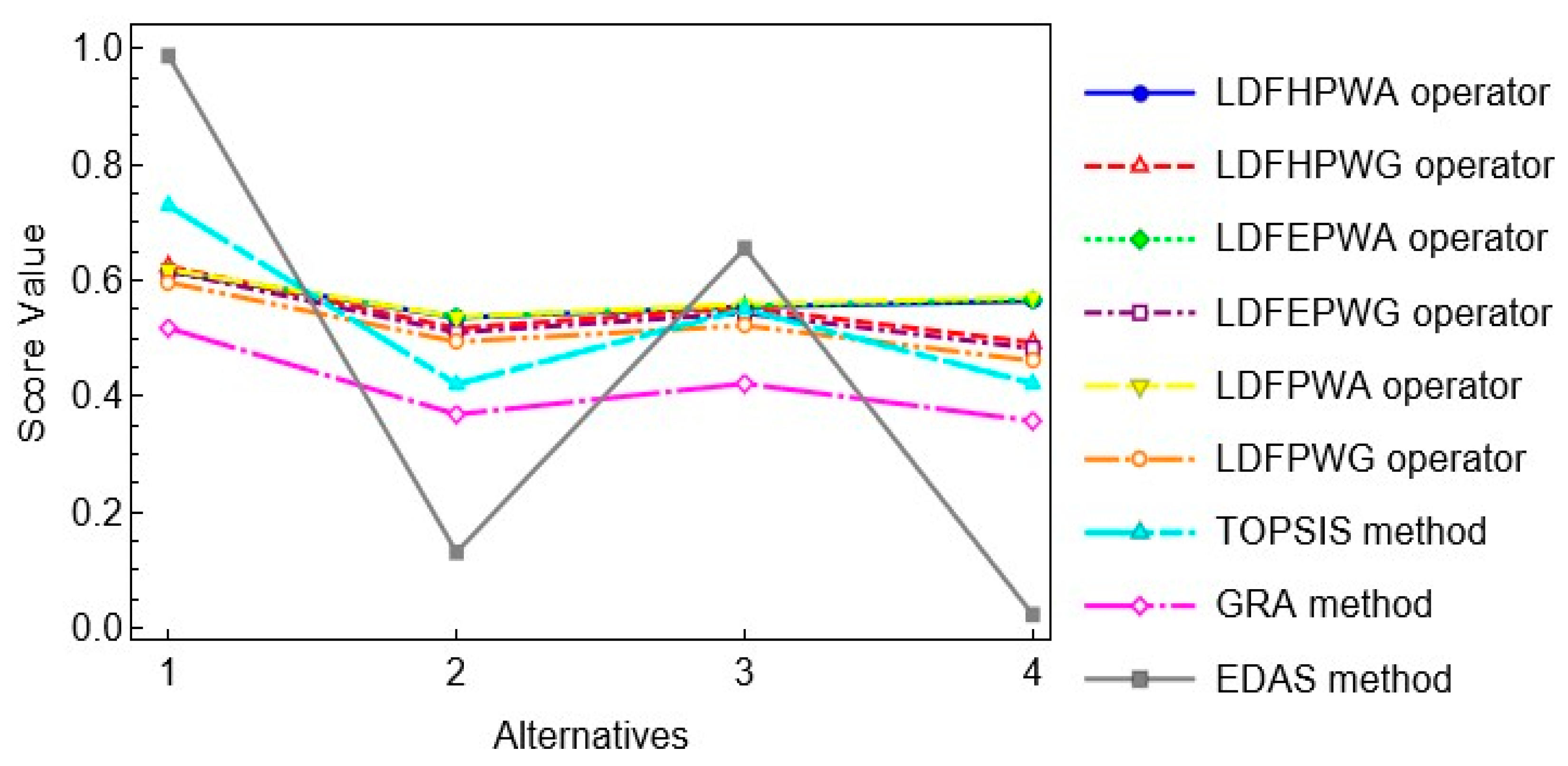

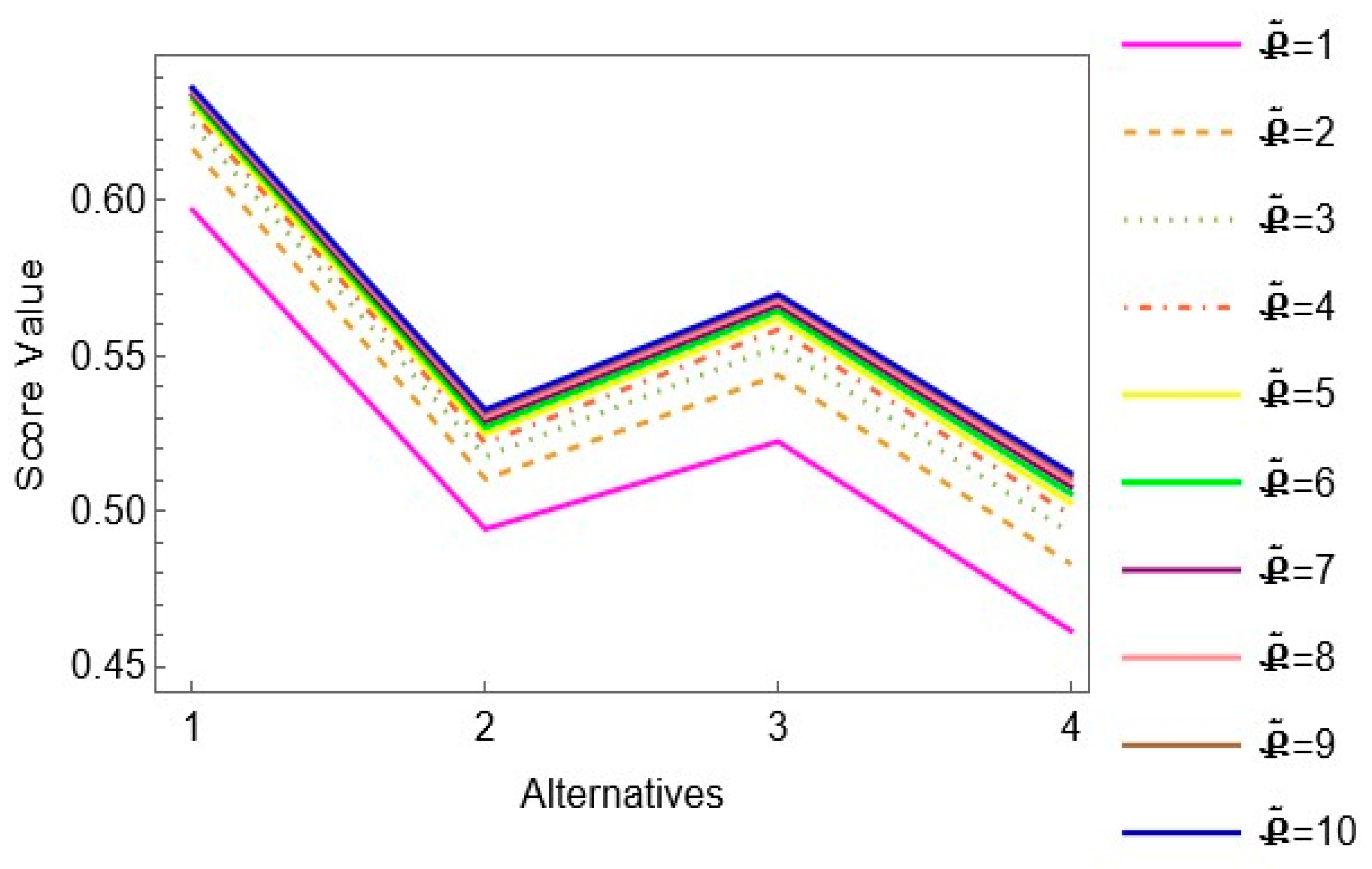
| Aggregated Alternatives | |
|---|---|
| Score Value | |
|---|---|
| 0.6158 | |
| 0.5359 | |
| 0.5547 | |
| 0.5647 |
| Ranking | |||||
|---|---|---|---|---|---|
| LDFHPWA operator | 0.6158 | 0.5359 | 0.5547 | 0.5647 | |
| Percentage | 0.006158 | 0.005359 | 0.005547 | 0.005647 | |
| LDFHPWG operator | 0.6244 | 0.5176 | 0.5531 | 0.4928 | |
| Percentage | 0.006244 | 0.005176 | 0.005531 | 0.004928 | |
| LDFEPWA operator [52] | 0.6171 | 0.5365 | 0.5564 | 0.5673 | |
| Percentage | 0.006171 | 0.005365 | 0.005564 | 0.005673 | |
| LDFEPWG operator [52] | 0.6167 | 0.5104 | 0.5438 | 0.4829 | |
| Percentage | 0.006167 | 0.005104 | 0.005438 | 0.004829 | |
| LDFPWA operator [51] | 0.6188 | 0.5374 | 0.5593 | 0.5714 | |
| Percentage | 0.006188 | 0.005374 | 0.005593 | 0.005714 | |
| LDFPWG operator [51] | 0.5969 | 0.4942 | 0.5224 | 0.4614 | |
| Percentage | 0.005969 | 0.004942 | 0.005224 | 0.004614 | |
| TOPSIS method [53] | 0.7297 | 0.4208 | 0.5505 | 0.4220 | |
| Percentage | 0.007297 | 0.004208 | 0.005505 | 0.00422 | |
| GRA method [54] | 0.5180 | 0.3690 | 0.4220 | 0.3575 | |
| Percentage | 0.00518 | 0.00369 | 0.00422 | 0.003575 | |
| EDAS method [55] | 0.9880 | 0.1307 | 0.6558 | 0.0230 | |
| Percentage | 0.00988 | 0.001307 | 0.006558 | 0.00023 |
| Ranking | |||||
|---|---|---|---|---|---|
| 1 | 0.6188 | 0.5374 | 0.5593 | 0.5714 | |
| 2 | 0.6171 | 0.5365 | 0.5564 | 0.5673 | |
| 3 | 0.6158 | 0.5359 | 0.5547 | 0.5647 | |
| 4 | 0.6148 | 0.5354 | 0.5534 | 0.5627 | |
| 5 | 0.6140 | 0.5351 | 0.5525 | 0.5612 | |
| 6 | 0.6134 | 0.5348 | 0.5518 | 0.5599 | |
| 7 | 0.6128 | 0.5345 | 0.5512 | 0.5588 | |
| 8 | 0.6123 | 0.5343 | 0.5506 | 0.5578 | |
| 9 | 0.6118 | 0.5341 | 0.5502 | 0.5570 | |
| 10 | 0.6114 | 0.5340 | 0.5498 | 0.5562 |
| Ranking | |||||
|---|---|---|---|---|---|
| 1 | 0.5969 | 0.4942 | 0.5224 | 0.4614 | |
| 2 | 0.6167 | 0.5104 | 0.5438 | 0.4829 | |
| 3 | 0.6244 | 0.5176 | 0.5531 | 0.4928 | |
| 4 | 0.6285 | 0.5219 | 0.5585 | 0.4987 | |
| 5 | 0.6310 | 0.5249 | 0.5620 | 0.5026 | |
| 6 | 0.6328 | 0.5271 | 0.5645 | 0.5056 | |
| 7 | 0.6340 | 0.5289 | 0.5663 | 0.5078 | |
| 8 | 0.6350 | 0.5304 | 0.5678 | 0.5096 | |
| 9 | 0.6358 | 0.5316 | 0.5690 | 0.5111 | |
| 10 | 0.6364 | 0.5327 | 0.5699 | 0.5123 |
Disclaimer/Publisher’s Note: The statements, opinions and data contained in all publications are solely those of the individual author(s) and contributor(s) and not of MDPI and/or the editor(s). MDPI and/or the editor(s) disclaim responsibility for any injury to people or property resulting from any ideas, methods, instructions or products referred to in the content. |
© 2025 by the authors. Licensee MDPI, Basel, Switzerland. This article is an open access article distributed under the terms and conditions of the Creative Commons Attribution (CC BY) license (https://creativecommons.org/licenses/by/4.0/).
Share and Cite
Hanif, M.Z.; Yaqoob, N. Prioritized Decision Support System for Cybersecurity Selection Based on Extended Symmetrical Linear Diophantine Fuzzy Hamacher Aggregation Operators. Symmetry 2025, 17, 70. https://doi.org/10.3390/sym17010070
Hanif MZ, Yaqoob N. Prioritized Decision Support System for Cybersecurity Selection Based on Extended Symmetrical Linear Diophantine Fuzzy Hamacher Aggregation Operators. Symmetry. 2025; 17(1):70. https://doi.org/10.3390/sym17010070
Chicago/Turabian StyleHanif, Muhammad Zeeshan, and Naveed Yaqoob. 2025. "Prioritized Decision Support System for Cybersecurity Selection Based on Extended Symmetrical Linear Diophantine Fuzzy Hamacher Aggregation Operators" Symmetry 17, no. 1: 70. https://doi.org/10.3390/sym17010070
APA StyleHanif, M. Z., & Yaqoob, N. (2025). Prioritized Decision Support System for Cybersecurity Selection Based on Extended Symmetrical Linear Diophantine Fuzzy Hamacher Aggregation Operators. Symmetry, 17(1), 70. https://doi.org/10.3390/sym17010070







